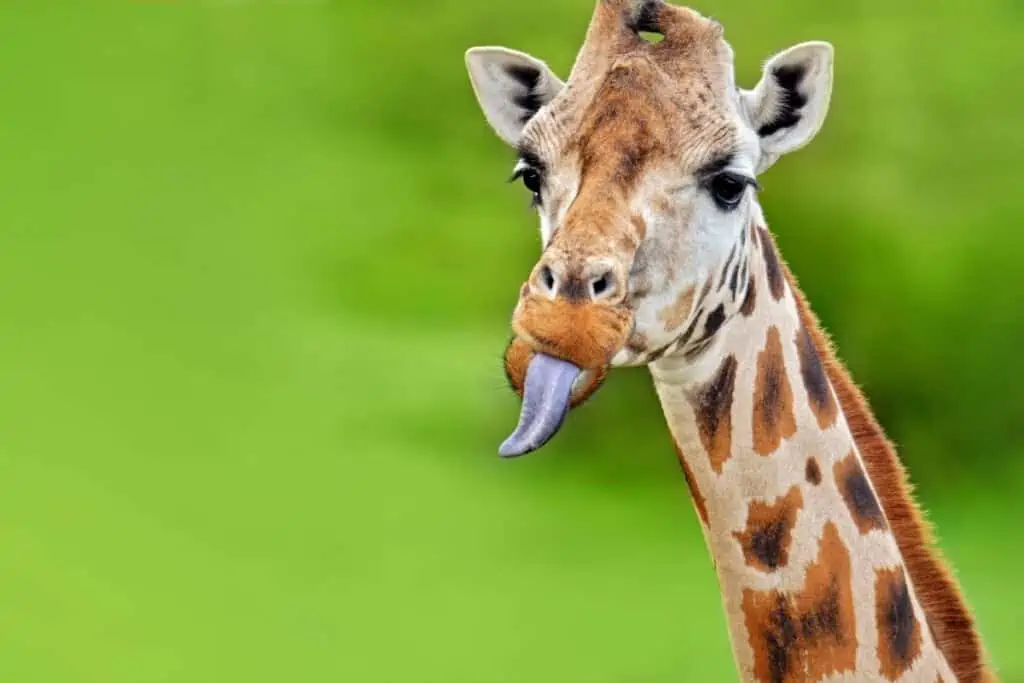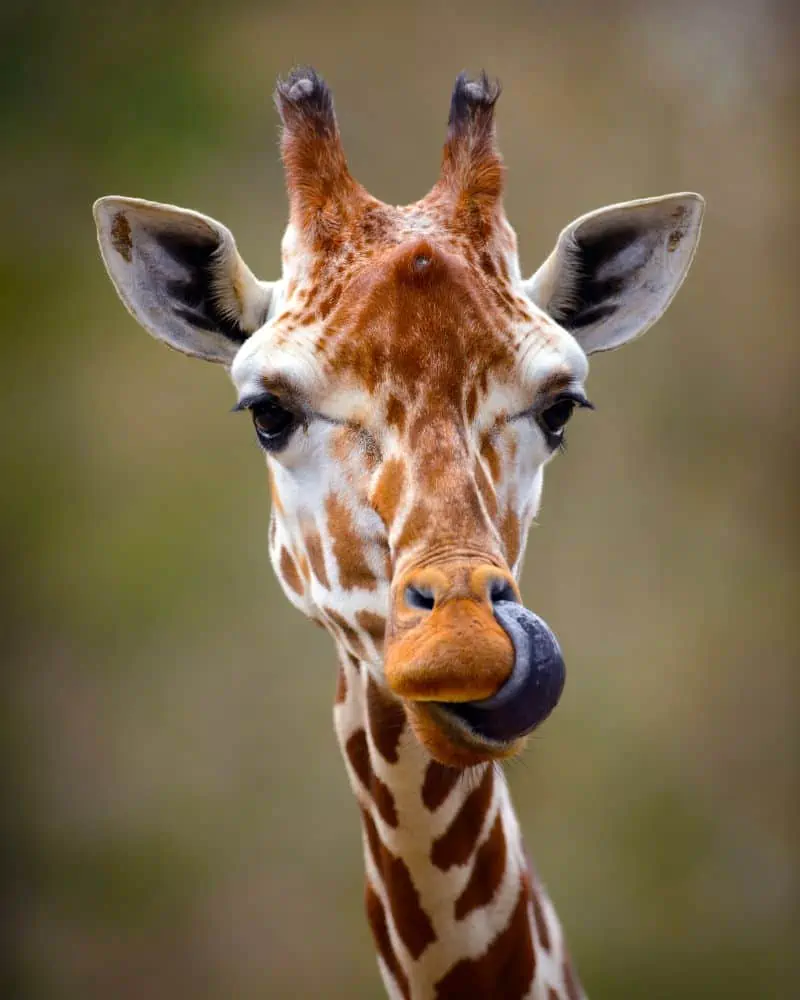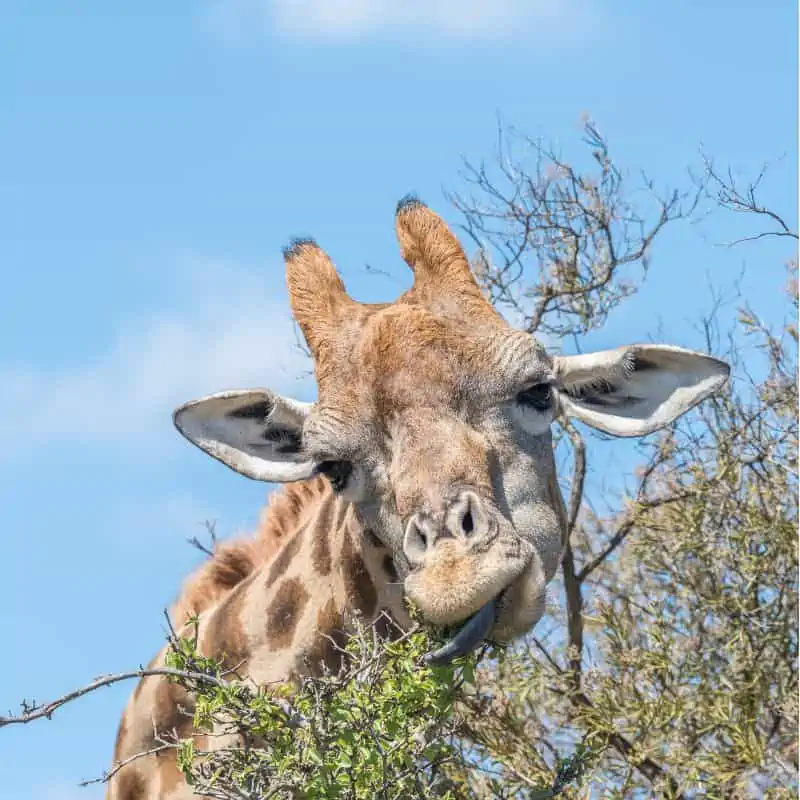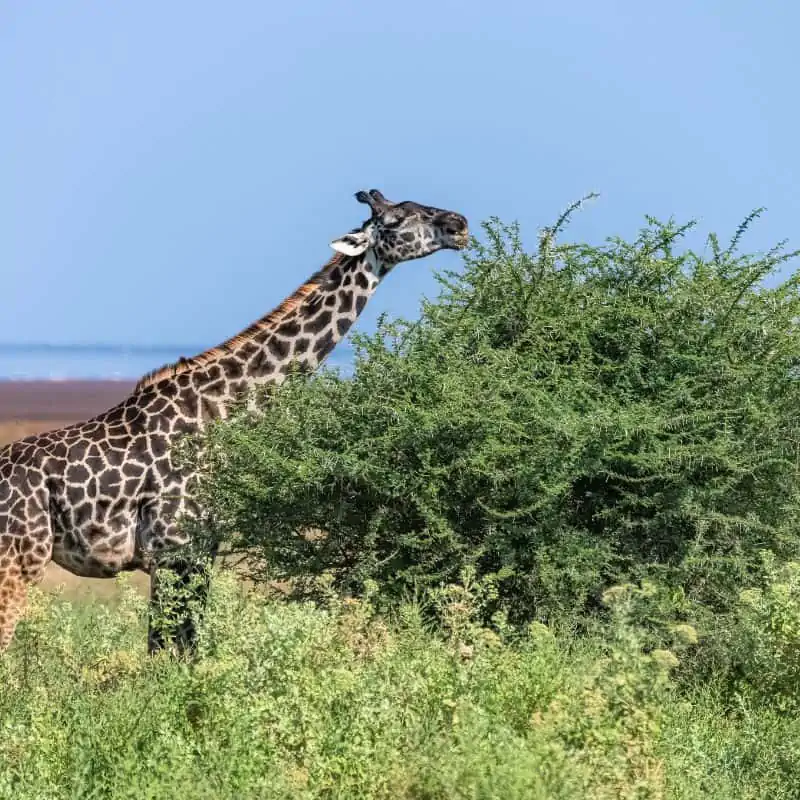Giraffes are the tallest land mammals in the world, and on top of their unique biological design, they are also incredibly fascinating creatures. Perhaps one of the most interesting attributes of the giraffe is its long prehensile tongue.
Here are 5 fascinating facts you probably didn’t know about the giraffe tongue.
- The tongue stretches around half a meter long
- It can come in different colors
- It is prehensile
- Their saliva is an antiseptic
- It’s adapted to their diet
The giraffe tongue is one of the most interesting tongues in all of nature, and it’s incredibly adapted to the giraffe’s needs. In this article, we’re going to take a closer look at this interesting tongue.

1. The tongue is half a meter long
The first interesting fact about the giraffe tongue that you’re probably familiar with if you’ve seen them eat is that they have very long tongues. These long muscular organs can be over 18 inches long (45 centimeters).
The length of these tongues is perfect for the giraffe’s diet. With their already tall stature, the extra length of the tongue allows them to reach super-high tasty leaves.
In particular, acacia trees, which are inaccessible to most other herbivores, are the primary food source of the giraffe because their leaves are the perfect height for a giraffe to reach. The tongue provides that extra little height to get at the leaves on the treetop.

2. Color of a giraffe tongue
If you’ve ever seen a giraffe up close, you probably have noticed the strange color of their tongues.
Even on a single tongue, the coloring usually isn’t consistent all the way through. The base of the giraffe’s tongue is a typical pink color, while the bottom area that leaves the mouth is a darker color.
Tongues can vary from a deep black to a bluish-purple color, and it’s largely due to the concentration of melanin in their tongues.
Although the exact reason why giraffes have so many melanin pigments in their tongue is unknown, people theorize that the melanin helps prevent sunburn, which allows the giraffes to feed as often as they need to without the worry of burning their tongues.
3. Their tongue is prehensile
The word prehensile when referring to a limb, appendage, or organ, denotes that the animal has precise control over its usage.
Giraffes have very precise control over their tongues so that they can accurately reach, grasp, and pull leaves with them. This effect is similar to an elephant’s trunk, which contains up to 40,000 muscles, allowing for very precise movements and controls.
This is a crucial feature in the giraffe’s survival because it allows them to have exceptional tongue-eye coordination to help them gather food and drink water.
Amazingly, giraffes have prehensile lips as well. This allows for the tongue and lips to work together to effectively strip the leaves from the branch and avoid ingesting any hazardous thorns.

4. Giraffe saliva is an antiseptic
Even with the most adept tongue and lips in the animal world, the giraffe may still end up getting a thorn in its mouth, but even if they do, its tongue is equipped to protect itself and heal quickly.
The thick saliva coats the thorn, reducing the risk of cuts inside the mouth. Better still, the saliva functions as an antiseptic should the tongue be cut by a thorn.
This biological adaptation reduces the risk of infection from the thorn and helps the giraffe survive. Antiseptics inhibit the growth of microorganisms or destroy them entirely—a death sentence for any harmful bacteria that could otherwise enter the bloodstream and cause an infection.
5. It’s Perfectly Adapted to Their Diet
The tongue is a remarkable muscular organ that helps a giraffe with every aspect of its life, but all of its unique features primarily contribute to one part of its life: diet.
Giraffes have adapted perfectly to feed on Acacia trees, even in a savannah teeming with other food options. Other tall trees like baobabs aren’t as practical, and, believe it or not, giraffes actually love the taste of acacia leaves as well, using their 200 taste buds to enjoy their meal.
Acacia trees are also the best food source for giraffes because they are tall and straight, allowing the giraffes to eat from them without having to bend their necks.
Some other animals like elephants can reach the lower branches of acacia, but no other animal has the biological resources to take advantage of this food source like giraffes can.
As such, their tongues have adapted to these demands, allowing giraffes to reach and consume food higher up in the branches where no other herbivore can reach.

Giraffes can bend their necks down to eat other shrubs, trees, and buds, but it’s not practical for them. Not only does this exert a lot more energy (just imagine the blood flow needed to move that neck), but it also leaves them more susceptible to predators when their head is down.
While they will consume other food sources, there’s no doubt that the acacia tree and the giraffe are a common sight in the African savannah.
The long, precise tongue is able to reach, grab onto, and pull off leaves for the giraffe to eat. While the tongue and lips are prehensile and work in tandem to remove any thorns that may be present.
Final thoughts on the giraffe’s tongue
The tongue of a giraffe is an amazing muscular organ that has a range of features to accommodate the giraffe’s very simplistic diet. With their long necks and precise tongues, giraffes can feast on the uppermost leaves of the acacia trees in locations where other herbivores simply can’t reach.
The melanin in their tongue is responsible for its odd coloring and helps protect them from the harsh sun, while the sticky saliva protects the tongue from thorns and greatly reduces the risk of infection.
The next time you see a giraffe, take a closer look at one of the most interesting tongues in the animal kingdom.
